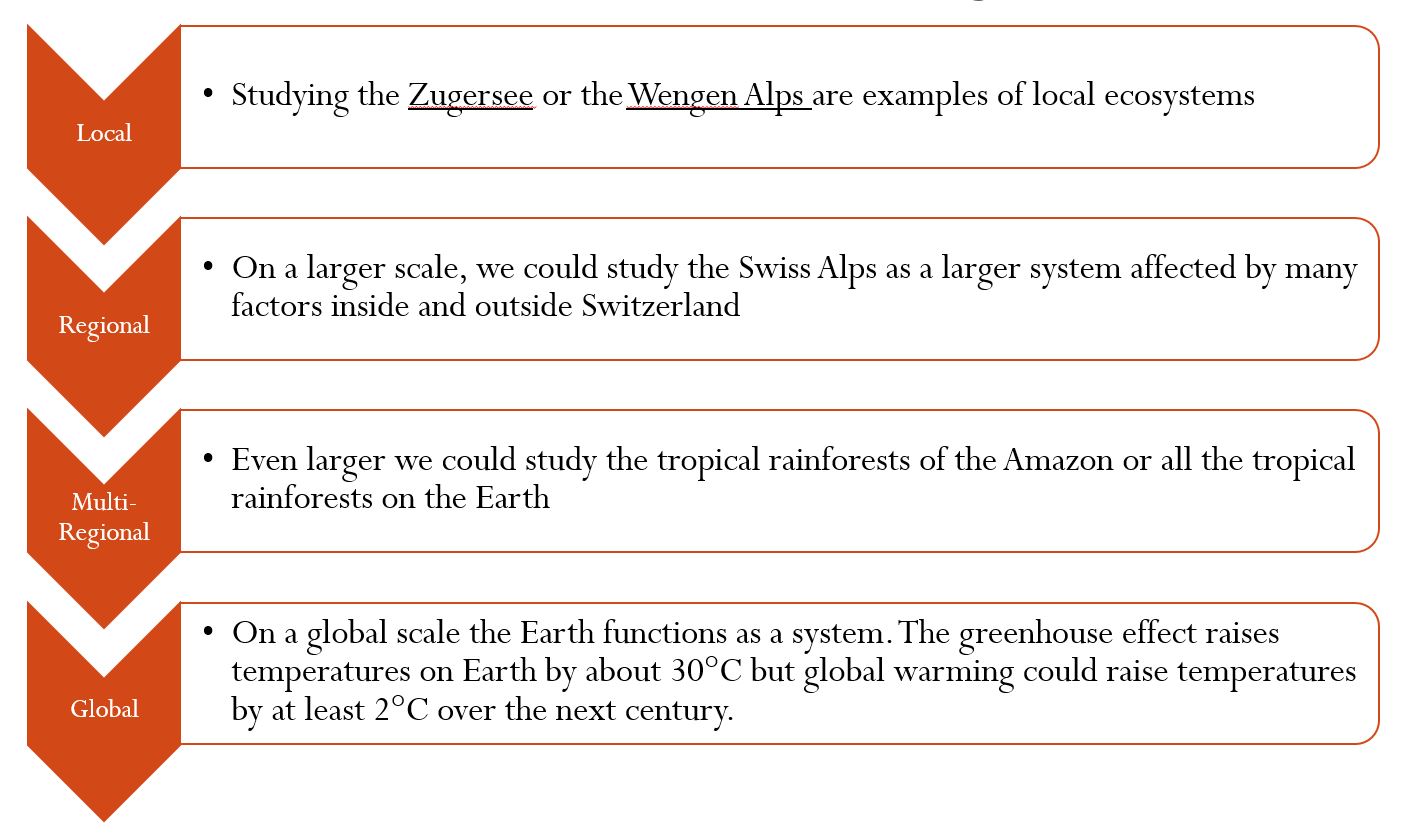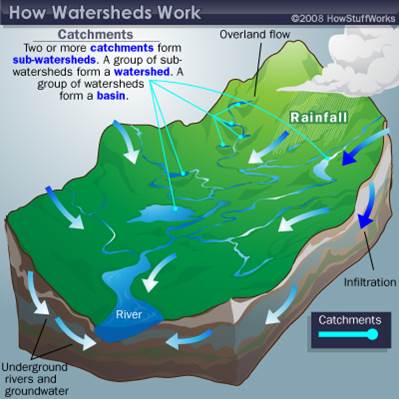1.2 Systems and Models
 Systems and Models
Systems and Models
I know that a lot of teachers don't teach this subtopic as a standalone unit but I find it very useful to introduce students to these crucial ideas at the start of the course; after all this is the fundamental thread of the course. What is a system? I want students to be able to take a systems approach to all the other topics. Thus, I keep it simple but ensure that students understand how to draw a system diagram and start to identify the components of a system. This helps them better understand the concepts of feedback, resilience and stability.
There are some good introductory ideas which you can come back to throughout the course such as the idea of what is a biosphere and James Lovelock's Daisy World.
Here is a student review activity What is a System?
Significant ideas:
- A systems approach can help in the study of complex environmental issues.
- The use of systems and models simplifies interactions but may provide a more holistic view without reducing issues to single processes.
Recommended Teaching Time (not including practicals): 2 hours
From the Guide
For the Knowledge Statements see the IB ESS Guide 2015 Subtopic 1.1
At the end of this topic the student should be able to:
- Describe a system with its flows, stores, transfers and transformations of energy and matter.
- Apply this to a variety of systems including unknown and novel systems to you including drawing a diagram to represent the system
- Understand the difference between open, closed and isolated systems and be able to identify a system as one of these.
- discuss why the global geochemical cycles approximate to closed systems
Checking Understanding: Are you Ready?
These questions can be answered using the resources for this sub-topic but you will need to return to them and apply them to other topics.
- Using an example, describe the concept of systems diagrams. Include the descriptors of flows, storages, transfers, transformations, and feedback loops.
- Compare and contrast open, closed, and isolated systems.
- Using an example, evaluate the use of models as a tool.
Student Activities
1.2 What is a System? The Basics
1.2 What is a System - Advanced
Lab Activities for PSOW
What is a System?

- the system if made up of component parts
- the parts work together
- the whole thing serves some purpose
Societal Systems

- Value Systems
- Economic Systems
- Social System
All these have an impact on the environment
Systems Interact

E.g. current changes in the Pacific Ocean can be associated with changing rainfall and runoff in parts of North and South America, drought conditions in North Africa, and air quality and food supplies in Europe (via El Niño).
Systems Occur on a Range of Scales

Four Main Environmental Systems
 Environmental systems include living (organic) and nonliving (inanimate) components, which interact to create the world around us. We can also consider our own values as a system as well as the economy and different social systems. There are different types of each of these based upon the inputs and outputs of the systems.
Environmental systems include living (organic) and nonliving (inanimate) components, which interact to create the world around us. We can also consider our own values as a system as well as the economy and different social systems. There are different types of each of these based upon the inputs and outputs of the systems.
There are four main environmental systems:
lithosphere: the rocks and minerals that form the solid body of the Earth
atmosphere: the layer of air surrounding the Earth’s surface
hydrosphere: water on and near the Earth’s surface
biosphere/ecosphere: the layer of living organisms of which humans are part
James Lovelock and The Gaia Hypothesis
 James Lovelock developed his Gaia hypothesis during the 1970s publishing several books and papers on the topic. The Gaia hypothesis proposes that the Earth functions as a living system, having a homeostatic mechanism which regulates conditions on the planet. The hypothesis is useful when thinking about the Earth as a system and particularly in view of the global changes occurring today. Several eminent scientists such as Richard Dawkins don't agree with Lovelock's proposals but others would argue that it is a useful way of debating the global system with feedback mechanisms maintaining an equilibrium.
James Lovelock developed his Gaia hypothesis during the 1970s publishing several books and papers on the topic. The Gaia hypothesis proposes that the Earth functions as a living system, having a homeostatic mechanism which regulates conditions on the planet. The hypothesis is useful when thinking about the Earth as a system and particularly in view of the global changes occurring today. Several eminent scientists such as Richard Dawkins don't agree with Lovelock's proposals but others would argue that it is a useful way of debating the global system with feedback mechanisms maintaining an equilibrium.
As part of the supporting evidence for the Gaia hypothesis, Lovelock developed a computer model called Daisyworld. This model demonstrates how emergent properties can develop from the interaction between non-living and living components of a system. Feedback loops develop to maintain a constant environment.
To read more about Daisyworld try here.
Here’s James Lovelock talking about the model:
And here's an explanation of his model
If you like playing with computer models try: NetLogo from Northwestern University.
System Boundaries
Systems operate within boundaries which can be defined. The boundary defines the limits within which the components interact, and thus it defines the scale of the system and the way in which systems are related together.
Environmental Systems are physical systems with physical boundaries. Some boundaries are sharp, such as coastlines or a lake shore, or a frontal weather system, which marks the boundary between warm and cold air masses. Other boundaries are less sharp and more transitional, such as the gradual change in vegetation towards a desert margin.

These terms should be applied when characterizing real systems.
• An open system exchanges matter and energy with its surroundings (for example, an ecosystem).
• A closed system exchanges energy but not matter; the “Biosphere II” experiment was an attempt to model this. Strictly, closed systems do not occur naturally on Earth, but all the global cycles of matter, for example, the water and nitrogen cycles, approximate to closed systems.
• An isolated system exchanges neither matter nor energy. No such systems exist (with the possible exception of the entire cosmos).
Exchanges Across Boundaries
System boundaries define what type of system it is, i.e. whether they exchange energy and / or material with the environment outside, so they are affected by and can in turn affect other systems. There are three types of system:
Isolated Systems
- no exchange of energy or material across the system boundaries
- such systems don't exist in the natural world
- the entire cosmos could be considered to be an isolated system
- Recently isolated caves have been discovered in which the source of energy is minerals in the rocks which are utilised by chemoautotrophs. Even these cannot be considered as isolated systems due to leakage of water, the occasional input of organisms or minerals from other systems.
Closed Systems
- exchange energy but not material across the system boundaries
- the global water cycle is a closed system because there is a fixed amount of material (water) within the system and the circulation of water is maintained by energy from the sun which comes across the system boundary.
- Other global cycles of minerals are also examples of closed systems.
- an artificial example is Biosphere II which was created by scientists in the USA
Open Systems
- exchange of energy and materials freely across the system boundary
- most environmental systems, such as drainage basins, lakes and forests, are open
